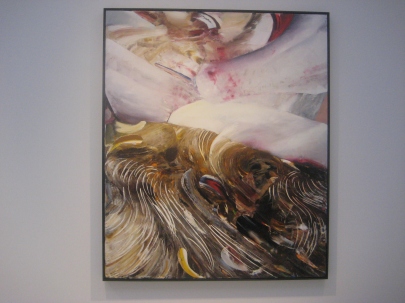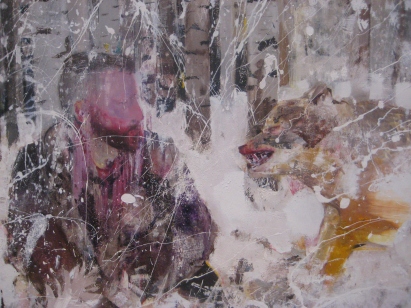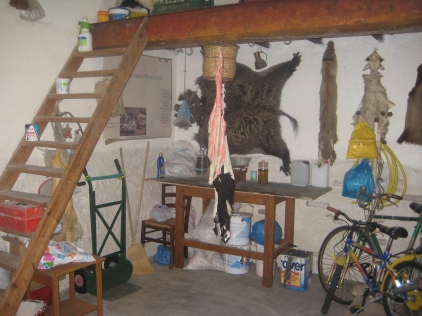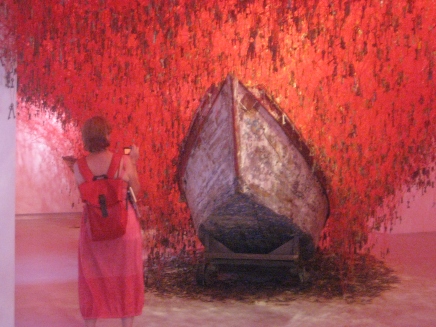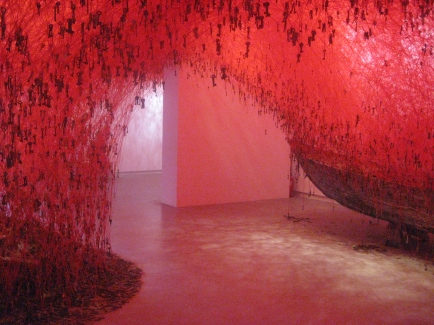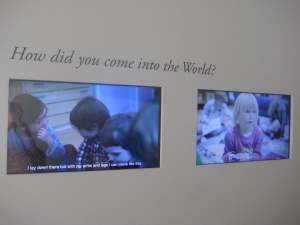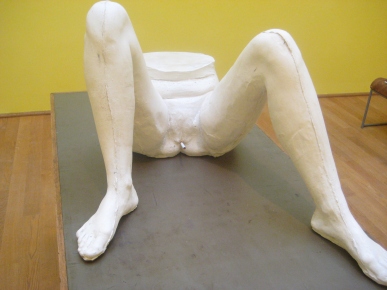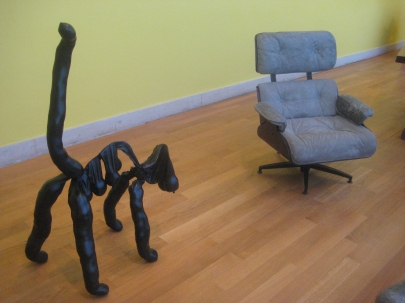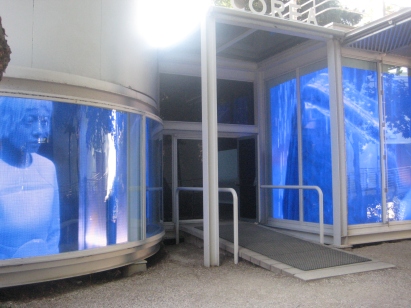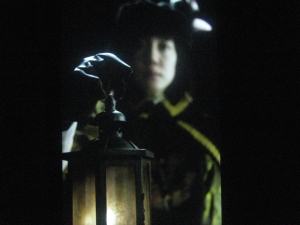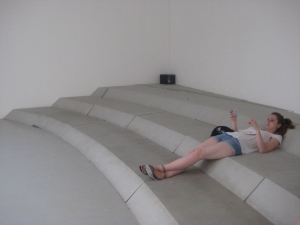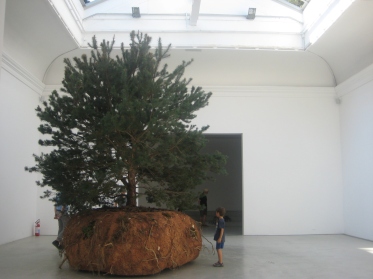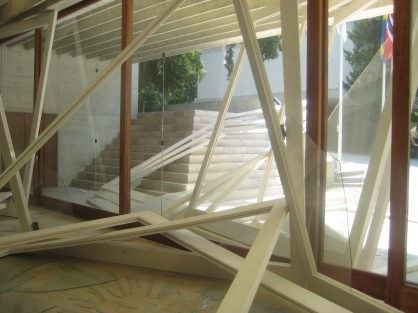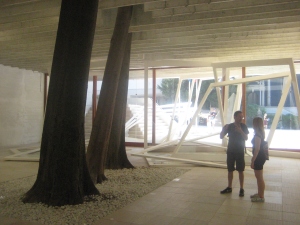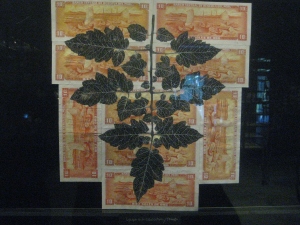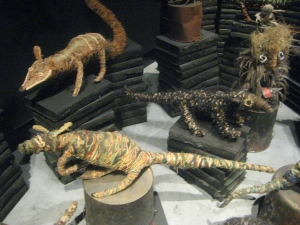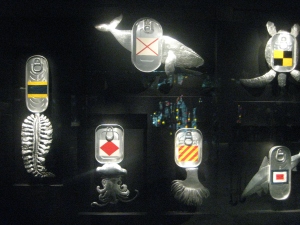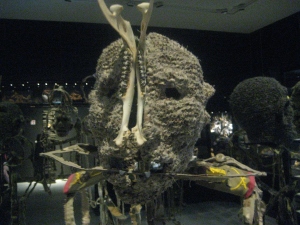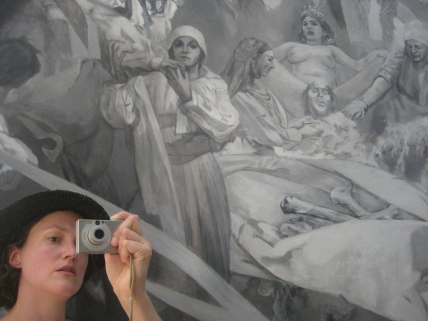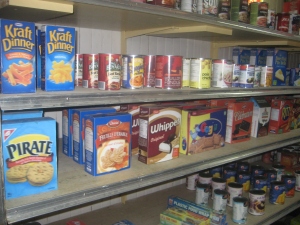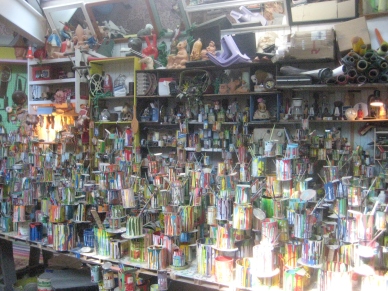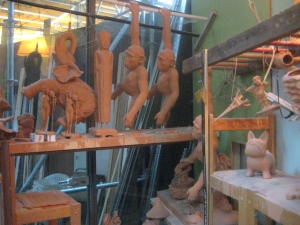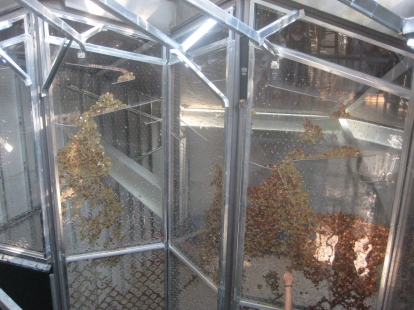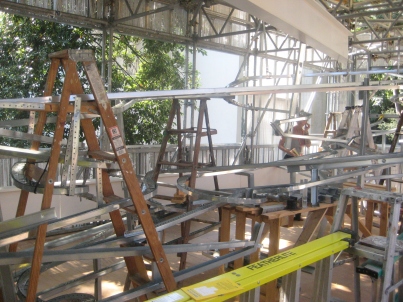As the Venice Biennale inches to a close in November, I finish my coverage of the national pavilions in Giardini. Despite my initial intention to provide an overarching view of this massive exhibit, I will draw the the line here and refrain from coverage of Arsenale- I’m starting to resent the breadth of this topic and really itching to get back into Toronto to meet and greet with some local artists! Just keep in mind when planning your own visit to Italy in the future the sheer volume of art on display during this massive exhibition.
So here goes, as promised, let’s begin with Romania.
Romania
Represented by painter Adrian Ghenie, his exhibition of works, entitled “Darwin’s Room,” was a kind of sleeper hit for me at the Biennale. This traditional display of paintings wasn’t an exhibition I had read about before attending. In it, Ghenie offers us an alternative interpretation of Darwin’s now unquestioned theories. His paintings feature rich natural scenes, a self-portrait of himself in the role of Darwin, diversely represented mythologies and glimpses from the futures arising from his fictional trajectories mixing science and apocrypha.
The symbolic subtext of this show is not its draw however. The work is exquisite. Ghenie wanders between the representational and the abstract through his alternating use of apparently spontaneous dry brushing alongside thickly spread colour mixtures segregated into amorphous shapes. Watch a beautiful video of the exhibition here.
Greece
Maria Padimitriou’s installation, “Why look at animals? AGRIMIKA, features a Greek animal hide shop transferred directly from Volos. The AGRIMIKA are animals that coexist with humans but refuse domestication. In this transference, Patimitriou encourages us to ponder all the varied aspects of civilization which separate us from our animal roots. A video presented off to the side of the exhibition shows a sentimental monologue by the owner of the shop. His reflections on his life, especially in regards to his search for meaning and insecurities about actualization, present a sentimental and provocative underpinning with which to view the work.
Japan
Chiharu Shiota’s installation, “The Key in the Hand,” has deservedly received a large amount of critical acclaim. Visually stunning and poignant, without being difficult to interpret, make this installation extraordinarily powerful and accessible for all viewers.
The installation is composed of thousands of keys strung between two boats “catching” a rain of keys. We hold our keys many times a day, and they serve to protect our most valuable assets, making them symbolic of the layered memories that compose the stories of our lives. The boats become symbolic of two hands, floating on a “sea of memories.”
Outside this portion of the installation is a photograph of a child’s hands holding a set of keys, as well as a series of videos featuring very young children recounting their memories of childbirth. Each portion of the installation is strong enough to stand alone. Together, they contextualize our concept of human memory as something shifting through our lives- like a boat- or easily lost or forgotten, such as the key in the hand.
Great Britain
The Brits chose to showcase one of their most infamous “YBA’s” ,(Young British Artists), Sarah Lucas. Criticism for her exhibition of sculptures, “I Scream Daddio” has focused on the choice to highlight work from a movement which has shown very little change since the artists involved in it were actually young. Admittedly, I enjoyed reveling in the spirit of the 90’s without wearing the ugly uniform now adopted by a new generation of youth. It’s also refreshing that at least on their home town turf, the YBA’s allure didn’t fade with their emergent status. I do believe Canadians could benefit from learning this lesson when supporting our own mid-career artists.
Republic of Korea
“The ways of Folding Space and Flying” was created by the artistic duo Mood Kyungwon and Jeon Joohho. The project consists of a series of large scale projections featuring a young woman in a sort of virtual reality laboratory. This young heroine, clad in futuristic white garb and white make-up, enters computer simulations that transport her into natural surroundings of the past. Her isolation gives one the feeling that she is completely alone in the future, experimenting with these various realities to make sense of her existence, or even just to alleviate the boredom of her sterile surroundings.
The title of the project is inspired two words originating in the Taoist practice. Chukjibeop is a hypothetical method of contracting physical distance. Bihaengsul explains the power to levitate, fly and travel across time and space. Through their fictional projections, the artists reflect on our absurd human desires to surpass the physical states which bind us.
France
Celeste Boursier-Mougenot’s installation, “revolutions,” offered the weary Biennale visitor a place to rest and reflect. A huge Scotch Pine moved slowly and subtly inside the pavillion, while two more of these wandering giants were creeping around outside on the gravel in front of the building. Spanning a semi-circle within the pavillion arranged specifically for viewing were “les marches” (the steps). Its not apparent that these are anything but concrete steps arranged for viewing the exhibition until one sits on them, and realizes that they are a kind of soft foam cut ergonomically to mold to the body for viewing.
By challenging simple expectations- inside vs. outside; hard vs. soft- Mougenot primes the viewer for deeper contemplation of the transmutations forced upon the trees within the installation, so that we can reflect upon all aspects of our perception.
Nordic Countries
Norwegian artist Camille Norment’s three part installation for the Nordic Countries pavillion is an attempt to create a multi-sensory exploration of a place “torn between poetry and catastrophe.” Visually, the pavilion represents a kind of disaster. Overlapping beams, layers of glass- shattered and intact, transport the viewer into a sterile accident. This is what happens when Elsa goes drinking.
The artist brings the element of sound into the installation through a strange symphonic soundtrack created by female voices and the glass armonica– an 18th century musical instrument using glass and water. This legendary instrument was banned due to fears that it would induce states of ecstasy and sexual arousal in women. It was feared that it had the power to cure and also to kill.
Australia
Fiona Hall’s installation, “Wrong Way Time,” pieces together hundreds of disparate elements to create a unified commentary on global politics, world finances and the environment. The space within the pavilion, its walls painted a severe black, is reminiscent of a kind of goth museum. Within each series, the artist presents macabre yet beautiful cautionary visions of an imagined, yet still remarkably accurate, history by combining western detritus with archetypes from non-western traditions.
Czech Republic and Slovak Republic
Years ago, before being moved to Prague, Alphonse Mucha’s “Slav Epic” was on display in a small broken down monastery in the town of Moravský Krumlov, Moravia. I arrived there by train from the dismal Czech city of Brno. It’s a travel memory I relish. As an educated fan of Secessionist Art and Alphonse Mucha, seeing the body of work that truly separated this graphic arts legend into the world of fine art mastery was a goal I was proud of accomplishing- especially because the location was so completely isolated.
For most casual observers, Mucha is still remembered for his cigarette ads and theatre posters. In “Apotheosis” Czech artist Jiri David pays tribute to Mucha’s greatest accomplishment and it’s historical significance as a documentary tribute to cultural group whose oppressions have oft been forgotten.
The installation presents a black and white reinterpretation of the painting “The Apotheosis of the Slavs: The Four Eras of the Slavs in Four Colours (1926)”, with an equal sized mirror in front of the painting. This mirror enables the viewer to view themselves, in colour, within the monochrome rendition as an invitation for self-reflection and pause to consider political and socio-cultural issues.
Canadassimo
At one point, as we wandered through the streets of Venice during the afterhours of the Biennale, I caught sight of someone paddling a canoe down the one of the canals. It might as well have been an apparition, but after visiting BGL’s simultaneously humorous and provocative exhibit, myself and my travel partner felt sure that this must be a lucky sighting of the artists at play in Venice.
Within the scaffolded walls of the Canadian pavilion, entrance into BGL’s installation begins through a Quebec depanneur. Within this carefully curated collection of Canadian convenience, everything is as it should be, though not quite. Labels seem to have been photocopied with a vague lenticular effect.
The installation progresses into the studio and living space of a fictional character. The sheer volume of “stuff,” constructed almost entirely out of recycled materials, brings our attention to the increasingly absurd preoccupation of recycling in a culture so possessed by consumption. The fanciful collection of imaginary clutter highlights the critical flaw in our most popular environmental strategy.
Continuing upstairs, one passes a layered plexi-glass mosaic created by the interactive portion of the installation on the top floor. Upstairs, winding troughs carry pocket change through a grandiose manifestation of a marble-race apparatus. Within the painful Italian heat and the sometimes prosaic interpretations of this year’s Biennale theme “All the World’s Futures,” Canada’s art rebels playfully showed the world we can do more than just stand-up comedy.
Stay tuned for more of what I do best, personal conversations with Canadian artists.

